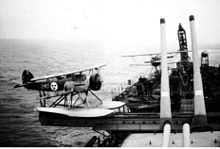HSwMS Gotland (1933)
%2C_1936.jpg) HSwMS Gotland in 1936 | |
| Career (Sweden) | |
|---|---|
| Name: | Gotland |
| Builder: | Götaverken |
| Laid down: | 1930 |
| Launched: | 14 September 1933 |
| Commissioned: | 14 December 1934 |
| Decommissioned: | 1956 |
| Struck: | 1960 |
| Fate: | Sold in 1962 and scrapped in 1963 |
| General characteristics | |
| Class and type: | Gotland-class cruiser |
| Displacement: | 4,600 t |
| Length: | 134.8 m |
| Beam: | 15.4 m |
| Draught: | 4.5 m |
| Propulsion: |
|
| Speed: | 27.5 knots |
| Complement: |
|
| Armament: |
|
| Aircraft carried: | Aircraft (before conversion):
|
| Notes: | Initially seaplane cruiser converted to anti-aircraft cruiser |
HSwMS Gotland was a seaplane cruiser of the Swedish Navy built by Götaverken.
The design of the ship started out in December 1926 as a seaplane carrier with room for twelve aircraft.[1] When presented with the design, Sweden's Naval Construction Board decided that it wanted the ship to have cruiser and minelaying functions as well as operating as a seaplane carrier.[1] The resulting 5,000-ton design presented in January 1927 proved impossible to build within the available budget of Sk16.5 million.[1] The design was then reduced in size requiring one of the forward turrets be removed.[1] Its guns were then placed in casements either side of the superstructure.[1] The construction contract for the ship was issued on 7 June 1930.[2]

Its aircraft complement consisted of six Hawker Osprey seaplanes. It had capacity for eight and attempts were made to purchase two more, unsuccessfully since production of the type had ceased. The aircraft were found to suffer from wave damage during rough weather, often forcing the ship to return to port.[3]
During World War II Gotland sighted the German battleship Bismarck when it broke out of the Baltic Sea. The sighting was reported to Swedish Navy headquarters but the message was intercepted by the British embassy, which triggered the allied chase of the great battleship.
HSwMS Gotland was converted in 1944 to an anti-aircraft cruiser due to a lack of modern seaplanes. This involved the removal of the seaplanes and the addition of four 40 mm Bofors guns and two 20mm L/70 guns.[3] The Ospreys continued in service from harbour bases with the last being retired on 2 December 1947.[4]
After World War II she served as a training ship. Starting 1953 and finishing in 1954 she was modified to allow her to serve as a fighter direction ship in the event of war as well as a training ship in peacetime.[3] She was decommissioned in 1956, struck off in 1960, sold in 1962 and finally scrapped in 1963.
References
- ↑ 1.0 1.1 1.2 1.3 1.4 Layman, R.D; McLaughlin, Stephen (1991). The Hybrid Warship The Amalgamation of Big Guns and Aircraft. Conway Maritime Press. p. 40. ISBN 0-85177-555-1.
- ↑ Layman, R.D; McLaughlin, Stephen (1991). The Hybrid Warship The Amalgamation of Big Guns and Aircraft. Conway Maritime Press. p. 41. ISBN 0-85177-555-1.
- ↑ 3.0 3.1 3.2 Preston, Antony (2002). The World's Worst Warships. Conway Maritime Press. pp. 108–111. ISBN 0-85177-754-6.
- ↑ Layman, R.D; McLaughlin, Stephen (1991). The Hybrid Warship The Amalgamation of Big Guns and Aircraft. Conway Maritime Press. p. 42. ISBN 0-85177-555-1.
External links
| Wikimedia Commons has media related to HMS Gotland (ship, 1933). |
- "From Northern Waters" 1936 Flight article on Gotland's aircraft operations
- World Aircraft Carriers List: Sweden
- Swedish Ship Involved - Aircraft Cruiser - HMS Gotland
- Gotland Class - Data
| ||||||||||||||||||||||||||||||||||||||||||||||